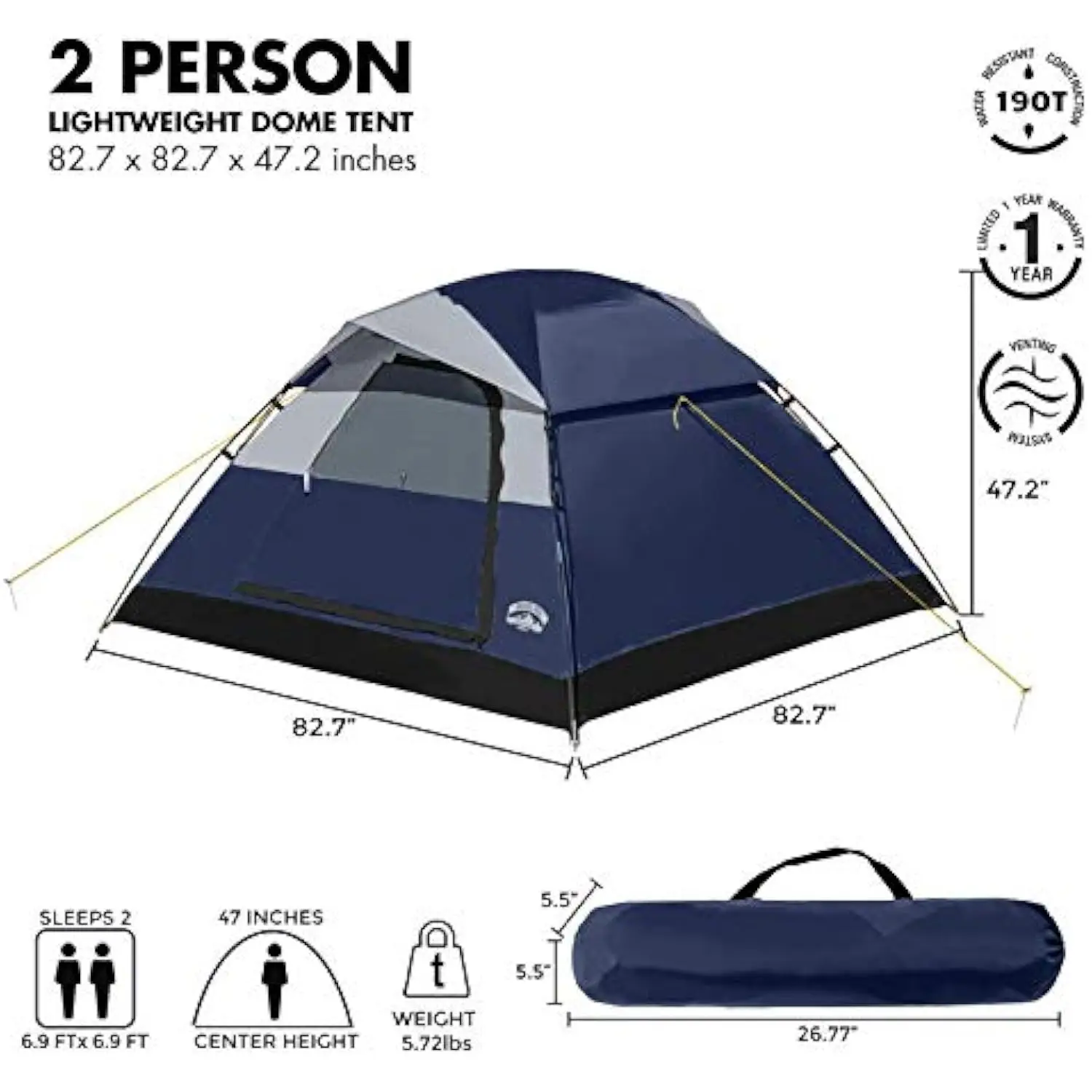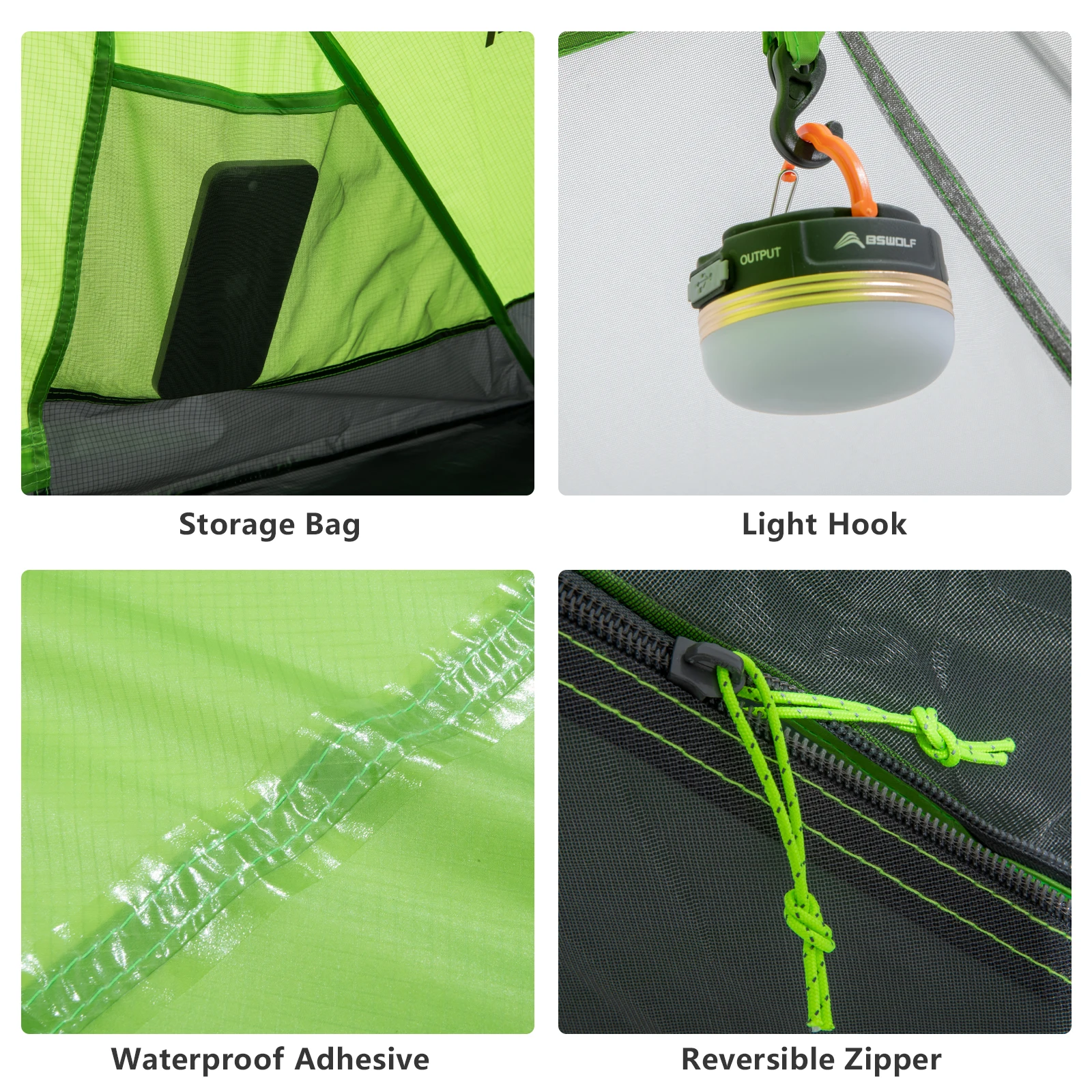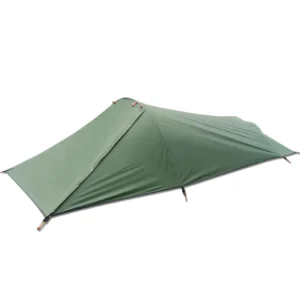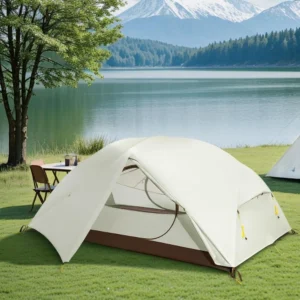Introduction: Maximizing Adventure, Minimizing Bulk
There’s something magical about camping with your partner—sharing breathtaking views, cooking meals under the stars, and creating memories that last a lifetime. However, finding the right tent that balances comfort with packability can be challenging for couples. You want enough room to sleep comfortably but don’t want to be weighed down by bulky gear that takes up precious space in your backpack or vehicle.
When we talk about “space-saving” tents for couples, we’re referring to shelters that offer a clever balance: compact and lightweight when packed yet surprisingly comfortable and functional when set up. The difference between standard and truly space-saving options can be significant—while a typical 2-person tent might pack down to the size of a large water bottle, space-saving designs can compress to nearly half that size.
At Explore Elements, we’ve tested dozens of tents across varied terrains and weather conditions to find those special designs that don’t force couples to choose between comfort and convenience. Our extensive experience in the backcountry has taught us what features truly matter when you’re sharing a small shelter with someone else.
This guide will help you navigate the sometimes confusing world of tent specifications to find your perfect balance of interior space and packed efficiency. Whether you’re weekend campers or dedicated backpackers, understanding the nuances of compact shelters for two campers will transform your outdoor experience together.
Our Top Space-Saving Tent Recommendations for Couples
Finding the perfect balance between comfortable interior space and minimized packed size doesn’t mean you have to sacrifice quality. Here’s a comparison of our top recommendations based on extensive field testing:
| Tent Model | Packed Size | Weight | Floor Area | Peak Height | Doors | Price Range |
|---|---|---|---|---|---|---|
| Alpine Hiker UL2 | 16” × 5” | 2 lbs 8 oz | 29 sq ft | 40” | 2 | $$$$ |
| Featherlight Pro | 14” × 4” | 1 lb 15 oz | 27 sq ft | 38” | 1 | $$$ |
| TrailDome 2 | 17” × 6” | 3 lbs 2 oz | 32 sq ft | 42” | 2 | $$ |
| SkyLoft 2P | 15” × 5” | 2 lbs 12 oz | 30 sq ft | 43” | 2 | $$$$ |
Best Overall: Alpine Hiker UL2
- Packed Dimensions: Compresses to just 16” × 5”
- Standout Feature: Unique hub-pole design creates near-vertical walls that maximize usable space
- Why It Works: Despite weighing only 2 lbs 8 oz, this tent offers a surprising amount of headroom and shoulder space—critical for two people sharing close quarters
- Real-World Performance: The dual vestibules provide 10 sq ft of additional covered storage space, keeping gear dry without sacrificing sleeping area
Most Compact: Featherlight Pro
- Packed Dimensions: Incredibly small 14” × 4” packed size
- Standout Feature: Single Y-shaped pole system reduces weight while maintaining structural integrity
- Why It Works: While it features only one door, the asymmetric design maximizes interior volume relative to floor area
- Real-World Performance: Fits two standard sleeping pads (20” wide) with no overlap and still leaves room for small personal items
Best Value: TrailDome 2
- Packed Dimensions: 17” × 6” packed size offers excellent space-to-value ratio
- Standout Feature: Pre-bent poles create extra interior volume without additional weight
- Why It Works: The slightly larger floor area (32 sq ft) provides breathing room for couples at a competitive price point
- Real-World Performance: Setup takes under 4 minutes and can be done by one person, even in challenging conditions
Most Innovative: SkyLoft 2P
- Packed Dimensions: 15” × 5” with unique compression stuff sack
- Standout Feature: Suspended interior mesh shelf system for maximizing organization
- Why It Works: Vertical walls and strategic pole placement create 43” of headroom—enough for most people to sit up comfortably
- Real-World Performance: The specialized vestibule design allows for cooking shelter in bad weather while maintaining ventilation
Learning to properly master two-person lightweight tent setup will dramatically improve your camping experience with any of these models. If you’re ready to explore more options, our collection of compact backpacking tents features additional models worth considering.
Understanding Tent Capacity Ratings: The “2-Person” Reality
When shopping for tents, you’ll quickly discover that manufacturer capacity ratings can be optimistic at best and misleading at worst. A standard “2-person” tent typically means the interior can technically fit two adults lying shoulder to shoulder with little to no extra space for gear or movement.
In reality, most couples need to consider:
- Actual Sleeping Pad Dimensions: Two standard sleeping pads (20” × 72”) placed side by side require a minimum width of 40”—and that’s with zero space between them
- Wider Pads: If either of you uses a wider pad (25”), you’ll need at least 45” of floor width for a comfortable fit
- Length Requirements: Taller individuals need to verify the floor length accommodates their full height plus a few inches for comfort
The comfort spectrum for two-person tents generally breaks down as follows:
* Cramped: Less than 28 sq ft floor area, under 38” peak height
* Functional: 28-32 sq ft floor area, 38-42” peak height
* Comfortable: Over 32 sq ft floor area, 42”+ peak height
Understanding whether a 2-person tent is actually big enough for your specific needs is crucial before making a purchase. Many couples find that a tent marketed as “2+ person” or a roomy 2-person model offers the best balance of space efficiency and comfort.
Packed Size & Weight: The True Space-Saving Factors
When evaluating how “space-saving” a tent truly is, packed dimensions and weight become the most critical factors. A truly space-efficient tent for couples should pack down to less than 18” in length and 6” in diameter—anything larger begins to consume significant pack space.
Understanding tent weight terminology helps make informed decisions:
* Trail Weight: Just the tent body, rainfly, and poles (typically what you’ll carry)
* Packed Weight: Everything included (stakes, guy lines, repair kit, stuff sacks)
* Minimum Weight: The absolute bare essentials needed for setup (sometimes called “fast fly” weight)
Material choices dramatically impact packed size:
* Silnylon vs. Standard Nylon: Silicone-impregnated nylon packs down 30-40% smaller than standard nylon with equivalent waterproofing
* DAC Featherlite Poles: These premium poles offer significant space savings compared to standard aluminum options
* Composite Stakes: Aluminum or carbon fiber stakes save substantial space over steel options
For different camping styles, aim for these weight ranges (for a complete 2-person tent):
* Ultralight Backpacking: 1-2.5 lbs
* Standard Backpacking: 2.5-4 lbs
* Car Camping (Space-Conscious): 4-6 lbs
Our ultralight 2-person tents collection features options specifically designed to minimize packed volume while maintaining functionality for couples.

Maximizing Interior Space: Beyond Floor Area
A tent’s floor dimensions tell only part of the story when it comes to livable space. For couples, how that space is configured matters tremendously for comfort during extended periods inside the tent.
Peak Height and Wall Angle
* A 40” peak height with near-vertical walls creates significantly more usable space than a 44” peak with severely sloped walls
* Look for tents that use pre-bent poles or hub designs, which create steeper walls without adding weight
* Optimal peak height for couples is 40-45”—enough for most people to sit up comfortably
Floor Shape Considerations
* Rectangular floors utilize space more efficiently for two sleepers than tapered designs
* Minimum comfortable width for two adults: 50-52” (allows small gap between sleeping pads)
* Strategic width distribution matters—some tents taper only at the foot end, preserving shoulder room
Volume-to-Weight Ratio
* This unofficial metric gives you a better idea of livable space per ounce carried
* Calculate by multiplying floor area by peak height, then dividing by weight in ounces
* Higher numbers indicate more efficient use of weight to create interior volume
Understanding what size tent is good for 2 people involves looking beyond simple dimensions to how the space works in practice. The best space-saving designs create an impression of roominess through clever architectural approaches rather than just expanding the footprint.
Door & Vestibule Configuration for Couples
For couples sharing a small tent, door and vestibule design significantly impact daily livability and convenience. Two doors with individual vestibules create a dramatically better experience than single-door designs by:
- Eliminating the need to climb over your partner for nighttime bathroom breaks
- Providing personal entry/exit and storage space for each person
- Improving ventilation options in various weather conditions
Vestibule considerations for space-efficient couple camping:
* Minimum Functional Size: Each vestibule should offer at least 5 sq ft to store a backpack and boots
* Vestibule Shape: Look for designs that maximize covered area while minimizing pole requirements
* Door Configuration: Doors that zip from multiple directions allow for partial opening in rain
Some innovative vestibule designs worth considering:
* Awning-Style: Can be propped open with trekking poles to create shade/cooking space
* Adjustable Coverage: Vestibules that can be rolled back partially for ventilation while maintaining some coverage
* Dual-Zipper Systems: Allow the top portion to be opened for ventilation while keeping the bottom closed for security
Our tents with vestibules collection features options with particularly well-designed external storage solutions, and our definitive guide on vestibule benefits explores these features in greater detail.
Smart Design Features That Save Space
The most innovative space-saving tents incorporate clever design elements that maximize livability while minimizing packed size:
- Hub-Style Pole Structures: Create more vertical walls and improved interior volume with minimal weight penalty
- Pre-Bent Pole Segments: Add significant interior volume at shoulder and head areas without increasing footprint
- Color-Coded Connection Points: Speed up setup time and reduce frustration
- Lightweight Materials Innovation:
- 7-10D silnylon rainflies pack down smaller than a softball
- 15-20D floor materials balance durability with minimal packed size
DAC Featherlite NSL poles reduce weight by 30% compared to standard aluminum
Strategic Interior Organization:
- Overhead mesh pockets suspend gear above sleeping area
- Integrated gear lofts utilize otherwise wasted peak space
Corner pockets keep essentials accessible without floor sprawl
Ventilation Systems:
- High/low venting creates airflow that reduces condensation
- Adjustable rainfly positioning allows customized airflow based on conditions
- Mesh panels positioned to maximize cross-breeze without compromising privacy
Looking for truly innovative designs? Our collection of best compact shelters for two showcases cutting-edge approaches to space efficiency.

Weather Protection & Durability: Balancing with Space-Saving
Creating an ultralight, space-saving tent often requires material compromises, but the best designs find the sweet spot between weight savings and durability:
Material Considerations:
* Rainfly Fabrics: Look for waterproof ratings of at least 1200mm hydrostatic head for reliable performance
* Floor Materials: Minimum 1500mm hydrostatic head with appropriate denier rating for your typical terrain:
* Established campsites: 20-30D is usually sufficient
* Rocky/rough terrain: Consider 30-40D or higher
* Pole Quality: Premium aluminum (like DAC) offers superior strength-to-weight ratio than fiberglass or basic aluminum
Season Ratings for Space-Saving Tents:
* 3-Season: The sweet spot for most couples (spring through fall camping) with good ventilation and moderate weather protection
* 3+ Season: Extended season capabilities with stronger poles and reduced mesh for better warmth
* 4-Season: Typically heavier and larger packed size, only necessary for winter camping or alpine conditions
Ventilation Strategy:
* Multiple vents positioned to create cross-flow reduces condensation
* Look for adjustable ventilation options that work even during rainfall
* Strategic mesh placement improves airflow while maintaining weather protection
For couples planning trips in challenging conditions, our waterproof backpacking tent selection offers options that don’t compromise on weather protection despite their compact packed size.
Setting Up Your Space-Saving Tent: Efficiency Tips
Mastering the setup of your compact tent not only saves time but can significantly enhance the tent’s performance:
- Practice at Home First: Familiarize yourself with the pole structure and attachment points before heading out
- Establish a System: Assign consistent roles if camping as a couple (one person handles poles, the other stakes)
- Start with the Footprint: Always begin by laying out and securing your ground cloth or footprint
- Strategic Staking: For non-freestanding tents, stake the foot end first, facing into the prevailing wind
- Proper Tensioning: Use all guy-out points, especially on the rainfly, to maximize interior volume
- Site Selection Tips:
* Choose slightly elevated ground to prevent water pooling
* Look for natural wind barriers in exposed areas
* Clear away pinecones, rocks, and debris before setup
Non-freestanding tents typically offer greater space savings when packed but require more attention to proper setup. Freestanding designs sacrifice some packability for convenience but can be pitched on any surface.
For a deeper understanding of selection criteria, our guide on choosing the ultimate compact shelter for two offers additional insights tailored to different camping styles and preferences.
Is a 3-Person Tent Better for Couples?
Many couples wonder if sizing up to a 3-person tent might be worth the extra weight and bulk. Here’s a balanced perspective:
Pros of Choosing a 3P Tent:
* Significantly more interior space for long-term comfort (typically 35-45 sq ft vs. 25-32 sq ft)
* Room for gear inside the tent rather than in vestibules
* Better option for larger individuals or those who move frequently during sleep
* More comfortable during extended weather delays when stuck inside
Cons of Sizing Up:
* 25-40% heavier on average (a quality 2P might weigh 3 lbs while its 3P version weighs 4 lbs)
* Larger packed size (typically 20-30% larger volume when packed)
* Higher cost (usually $50-100 more than the 2P equivalent)
* Requires larger tent sites, which can be harder to find in popular backcountry areas
When to Choose a 3P:
* Car camping where weight/packed size matters less
* Longer trips where in-tent comfort becomes more important
* If either partner is particularly tall or broad-shouldered
* When you frequently camp in rainy conditions and need indoor gear storage
For space-efficient larger options, our compact dome tents for couples collection includes several models that balance the benefits of extra space with reasonable packed dimensions.
How to Maximize Space in Smaller Tents
Even the most compact tent can feel surprisingly spacious with these organizational strategies:
- Use compression sacks for clothing and sleeping bags to minimize their packed volume
- Store small items in stuff sack pockets that can hang from interior loops or attach to gear lofts
- Arrange sleeping pads at slight angles when possible to create more shoulder room
- Position backpacks in vestibules with rain-sensitive items facing inward
- Utilize vertical space with aftermarket gear lofts and hanging organizers
- Keep headlamps and essentials in overhead mesh pockets for easy access
- Consider ultralight sleeping pads (tapered designs save significant space)
- Use packable camp pillows instead of bunched-up clothing for better space efficiency
Lightweight Backpacking Tent, Ultralight Backpacking Tent, Ultralight Bivy Tent
Ultralight Single Person Camping Tent with Aluminum Poles for 3-Season Backpacking Waterproof DesignPrice range: $94.88 through $326.82 Select options This product has multiple variants. The options may be chosen on the product pageLightweight Backpacking Tent, Ultralight Backpacking Tent, Waterproof Backpacking Tent
$391.05 Select options This product has multiple variants. The options may be chosen on the product pageCompact Backpacking Tent, Lightweight Backpacking Tent, Waterproof Camping Tent
$335.52 Select options This product has multiple variants. The options may be chosen on the product pageUltralight Backpacking Tent, Ultralight Dome Tent, Winter Camping Tent
Price range: $369.63 through $370.07 Select options This product has multiple variants. The options may be chosen on the product pageHeavy Duty 4 Season Tent, Ultralight Freestanding Tent, Winter Camping Tent
$3,722.66 Select options This product has multiple variants. The options may be chosen on the product pageBackpacking Tent with Vestibule, Freestanding Backpacking Tent, Lightweight Backpacking Tent
Price range: $446.89 through $447.22 Select options This product has multiple variants. The options may be chosen on the product page
The way you pack your tent also impacts how much space it consumes in your backpack. Learning proper tent packing tips can reduce packed size by up to 15% compared to haphazard stuffing methods.

Are Ultralight Tents Worth It for Couples?
“Ultralight” generally refers to two-person tents weighing under 2.5 pounds, but this weight savings comes with important considerations:
Benefits of Ultralight Options:
* Dramatically reduced pack weight (sometimes 1-2 pounds lighter than standard options)
* Smaller packed size, often 30-40% less volume than conventional tents
* Less fatigue during longer hikes, potentially allowing you to cover more distance
Drawbacks to Consider:
* Premium pricing (typically 30-80% more expensive than standard tents)
* Thinner materials require more careful site selection and handling
* Potentially shorter lifespan with regular use
* Often less freestanding, requiring good staking options
When Ultralight Makes Sense:
* For backpacking trips covering significant mileage
* When every ounce and cubic inch of pack space matters
* If you’re experienced enough to handle the specialized setup and care
* When you can dedicate the budget to premium materials
For those ready to make the investment, our ultralight backpacking tent collection features options that represent the cutting edge of space-saving design.
How to Care for Your Space-Saving Tent
Proper maintenance is essential for preserving your tent’s packability and performance:
- Never store your tent compressed for extended periods—hang it or store loosely in a cotton bag
- Clean with gentle methods only—use mild soap and soft cloth for spot cleaning
- Completely dry before storing to prevent mildew that can damage waterproof coatings
- Fold lightweight poles rather than allowing them to snap together to prevent cord damage
- Use proper folding technique that follows manufacturer recommendations to maintain waterproof coatings
- Apply seam sealer annually to maintain waterproofing at stitching points
- Address small tears immediately using appropriate repair tape designed for outdoor gear
- Consider footprint use to extend the life of ultralight floor materials
For couples exploring different shelter setups beyond traditional tents, our guide to camping shelter options for two offers alternative approaches that might better match your specific needs.
Frequently Asked Questions
Q: Can we really fit comfortably in a compact 2-person tent?
A: Yes, but look for models with at least 28-30 square feet of floor space and a peak height of 40+ inches. Two standard-width sleeping pads (20” each) should fit side by side with a small gap.
Q: Are single-wall tents a good space-saving option?
A: Single-wall tents typically pack down 15-25% smaller than double-wall equivalents but are more prone to condensation issues. They work best in drier climates or during seasons with lower humidity.
Q: How much should we expect to spend on a quality space-saving tent for two?
A: For a well-designed space-saving tent that balances durability with packability, budget between $250-400. Ultralight specialized models can reach $500+, while budget options with slightly larger packed sizes start around $150.
Q: Are tent footprints worth the extra packed size?
A: For ultralight and compact tents with thinner floor materials (especially those under 20D), yes. Many footprints now pack down to the size of a deck of cards and add only 3-6 ounces while significantly extending tent life.
Q: How do bikepacking tents differ from standard backpacking tents?
A: Bikepacking-specific tents typically feature shorter pole segments (easier to pack on a bike), modular components for flexible packing, and often prioritize packed shape (thin and long) over absolute smallest volume.
Our freestanding backpacking tent collection includes several options particularly well-suited to beginners looking for hassle-free setup without sacrificing packability.
Takeaway: Finding Your Perfect Balance
The ideal space-saving tent for you and your partner ultimately depends on your specific camping style, terrain preferences, and comfort needs. Rather than pursuing the absolute lightest or most compact option on the market, focus on finding the sweet spot where comfort and convenience meet reasonable packed size.
Consider which features matter most for your particular situation—double doors might be essential for some couples, while others prioritize extra headroom or vestibule space. Remember that even the most compact tent should ultimately enhance your outdoor experience rather than detract from it.
Whether you choose an ultralight marvel that disappears in your pack or a slightly more spacious option with additional comfort features, the perfect tent will enable more adventures together with less hassle. And that’s the true measure of a successful space-saving tent for two.







